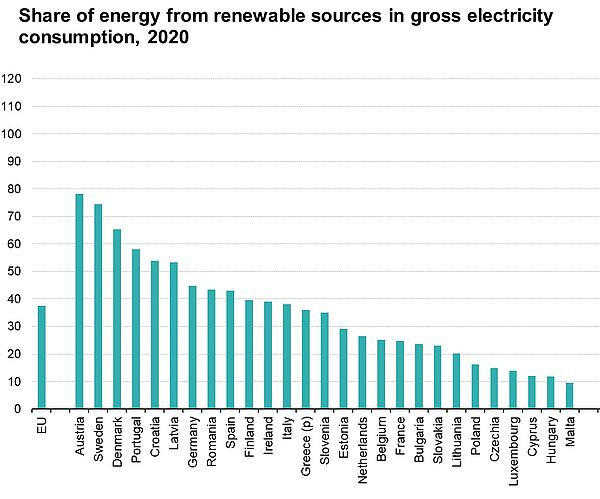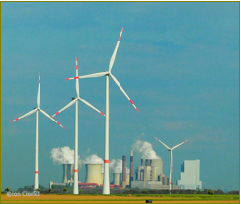According to recent data published by Eurostat, in 2020, the European Union exceeded the planned share of gross final energy consumption from renewable sources by 2%. Thus, 22% of the energy consumed in the EU is produced from renewable sources, compared with 9.6 % in 2004.
As you can see from the figure below, 23 countries of the EU exceeded their target levels for 2020. Slovenia, the Netherlands, and Belgium managed to meet their targets whereas France with -3.9% is the only one EU country which failed to meet its target. The member states that markedly overachieved their 2020 targets were Sweden, Croatia (both +11 %) and Bulgaria (+7%).
Sweden with about 60% had the highest share of gross final energy consumption from renewables among EU member states in 2020, ahead of Finland (44%) and Latvia (42%). By contrast, the lowest share of renewables was recorded in Malta (11%), followed by Luxembourg (12%) and Belgium (13%).
In terms of EU electricity data, 37.5% of gross electricity consumption fell to renewables in 2020, up from 34.1% in 2019.
Source: Eurostat
More than two-thirds of the total electricity produced from renewables was from wind and hydropower (36% and 33%, respectively). 14% of electricity was produced from solar power, 8% from solid biofuels and 8% from other renewable sources. It should be noted that solar power is the fastest growing source: it accounted for only 1% in 2008.
The figure below presents the share of energy from renewables in gross electricity consumption in 2020. As we can see, Austria is the absolute leader in energy production from renewables, with 78.2%. It is followed by Sweden with 74.5% and Denmark (65.3%). More than half of the electricity consumed comes from renewables in Portugal (58%) and Latvia (53.4%). At the other end of the scale, are the EU Member States with less than 15% share of renewable electricity – Malta, Hungary, and Cyprus.
Source: Eurostat
If we take the heating and cooling sector in the EU, renewables will account for 23.1% of the total energy used for heating and cooling, up from 11.7% in 2004. This growth has been made possible by the development of the industrial sector, the service sector, and households. In the EU, the share of energy from renewables in heating and cooling was more than half in Sweden (66.4%), Estonia (57.9%), Finland (57.6%) and Latvia (57.1%). Member states with less than 10% share of renewable energy in heating and cooling include Ireland (6.3%), the Netherlands (8.1%) and Belgium (8.4%).
In the transport sector, the average share of energy from renewable sources in 2020 was 10.2%, which is in line with the overall target of 10%. Considering that this share was only 1.6% in 2004, the increase can be regarded as quite high. Compared to 2019, all EU member states except France and Finland recorded an increase in the average share of energy from renewable sources in transport, with the largest increases seen in Estonia, Luxembourg, Belgium, and Cyprus. Regardless of its successful results in 2020, the absolute leader in renewable energy in transport is Sweden, where they account for almost 32% of transport fuel consumption, followed by Finland (13.4%) and the Netherlands (12.6%).
The fact that the EU has met and even exceeded the 2020 targets can be seen as an important milestone on the EU's way to becoming climate-neutral by 2050.
